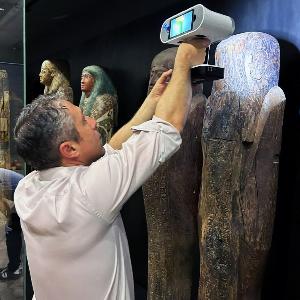Staatliches Museum Ägyptischer Kunst


The ongoing partnership between the Institute for Digital Cultural Heritage Studies and the Staatliches Museum Ägyptischer Kunst (SMAEK) represents a significant milestone in the digital preservation and analysis of ancient artifacts. Central to this collaboration is creating digital twins of the museum's invaluable items, ensuring their detailed documentation for future study and preservation.
Technology Employed: To scan SMAEK artifacts, we use an Artec Leo structured light laser scanner, a leading tool known for its precision and high-definition capabilities, to digitize the artifacts. This cutting-edge scanner allowed us to create 3D reconstructions of ancient Egyptian decorated coffins and several fragments of Egyptian statues stored at the Louvre Museum in Paris.
A key objective of our project was to compare different methodological approaches applied to the same objects. Specifically, we focused on Egyptian coffins, comparing the photogrammetric technique with 3D reproduction using the Artec LEO scanner. This comparative study assessed the quality and speed of data capture, post-processing efficiency, and the costs and benefits of each method.
One of the most remarkable outcomes of our collaboration was the enhanced capability to analyze the engravings on the coffins' surfaces with extreme precision. These engravings include intricate artistic representations of humans, animals, deities, and hieroglyphics. The high-definition meshes produced by the Artec LEO scanner allowed us to observe even the tiniest engraved details with very high accuracy, revealing aspects that are often difficult to discern with the naked eye.
We are confident that this project will significantly advance the research, study, and interpretation of ancient Egyptian artifacts. Given the SMAK museum's strong interest in new technologies and digitalization, we aim to enhance its vital digital collection by creating 3D models throughout the project development.
This digitization effort preserves the artifacts digitally and is an invaluable resource for researchers, students, and the public.